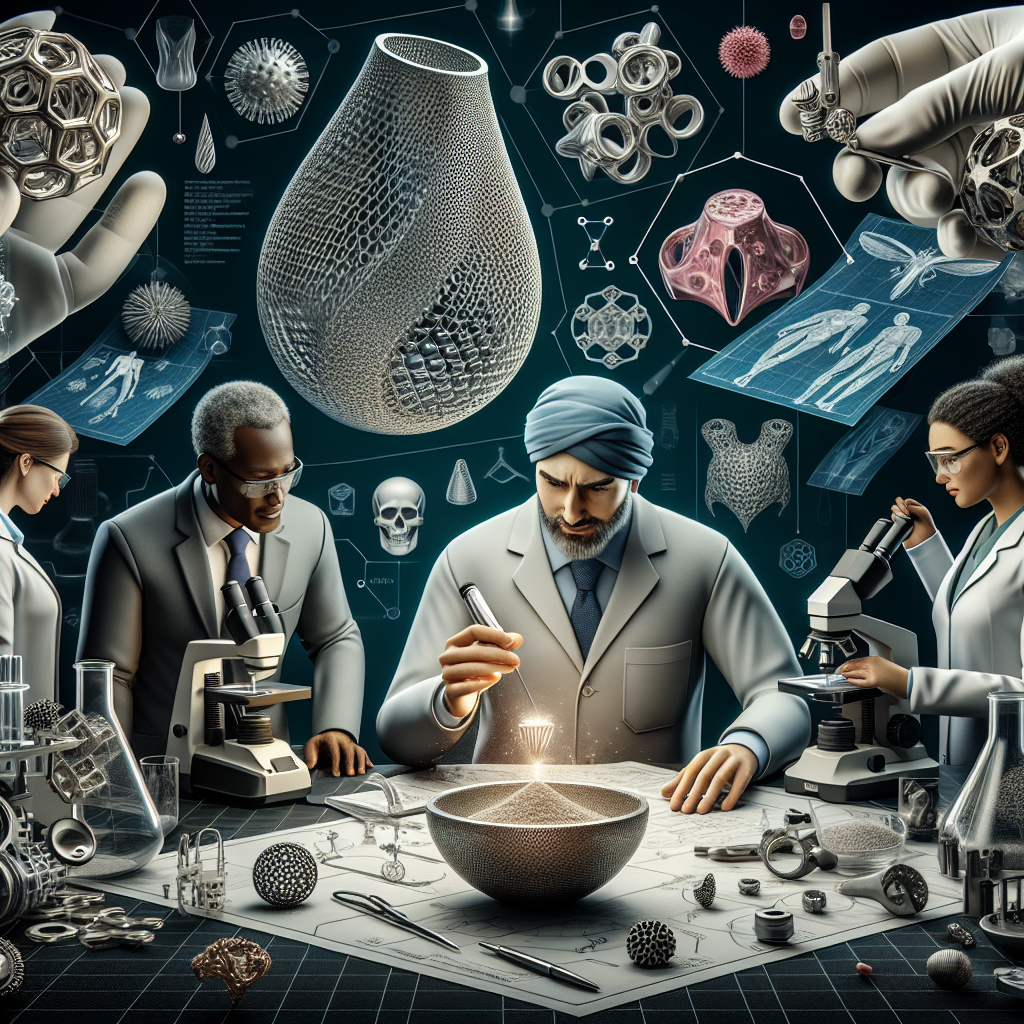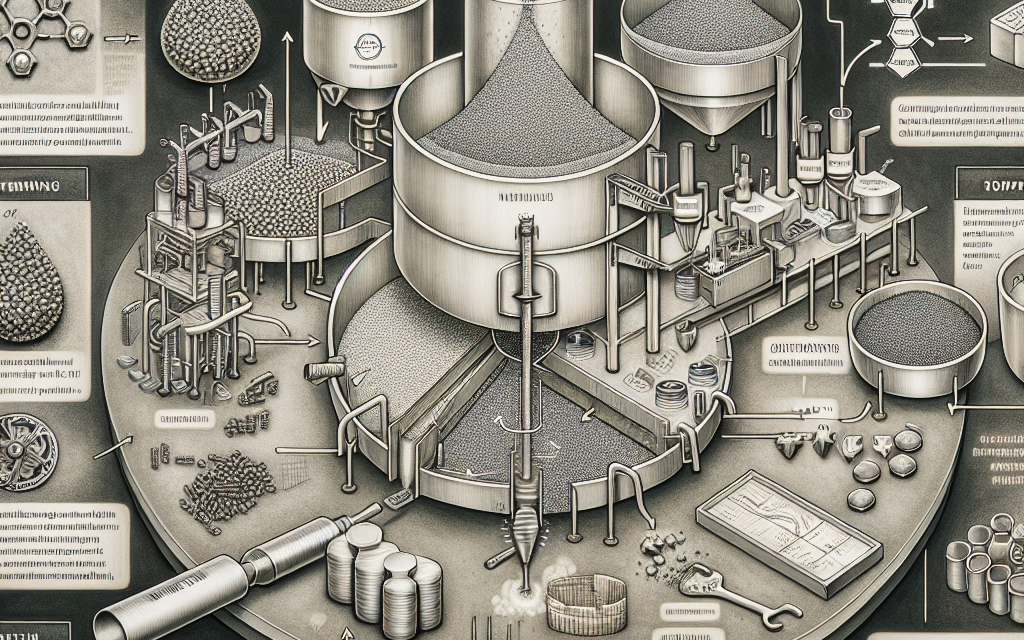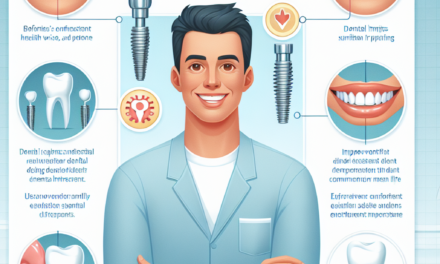Enhancing Medical Implant Biocompatibility with Powder Metallurgy Methods

Medical implants have revolutionized healthcare, offering solutions for a variety of conditions that were once deemed untreatable. However, the success of these implants largely depends on their biocompatibility. Powder metallurgy (PM) methods have emerged as a promising approach to enhance the biocompatibility of medical implants. This article delves into the intricacies of powder metallurgy and its application in improving implant biocompatibility, providing a comprehensive overview of the subject.
Understanding Powder Metallurgy in Medical Applications
Powder metallurgy is a manufacturing process that involves the production of components from powdered materials. This technique is particularly advantageous in the medical field due to its ability to produce complex shapes and structures with high precision. The process typically involves four main steps: powder production, blending, compaction, and sintering.
In the context of medical implants, powder metallurgy offers several benefits. It allows for the creation of porous structures that can mimic the natural bone architecture, promoting better integration with the surrounding tissue. Additionally, PM enables the incorporation of bioactive materials that can enhance the biological response of the implant.
Powder Production Techniques
The first step in powder metallurgy is the production of metal powders. Various techniques are employed to produce these powders, each with its own set of advantages and limitations. Common methods include atomization, mechanical alloying, and chemical reduction.
- Atomization: This process involves the disintegration of molten metal into fine droplets, which solidify into powder particles. Atomization is widely used due to its ability to produce high-purity powders with controlled particle size distribution.
- Mechanical Alloying: This technique involves the repeated fracturing and welding of powder particles in a high-energy ball mill. It is particularly useful for producing composite powders with unique properties.
- Chemical Reduction: In this method, metal oxides are reduced to metal powders using a reducing agent. Chemical reduction is often used for producing powders of metals that are difficult to atomize.
Each of these techniques can be tailored to produce powders with specific characteristics, such as particle size, shape, and composition, which are crucial for the subsequent steps in the PM process.
Blending and Compaction
Once the metal powders are produced, they are blended with other materials to achieve the desired properties. This step is critical for ensuring uniformity in the final product. Additives such as binders, lubricants, and alloying elements may be included to enhance the mechanical and biological properties of the implant.
Compaction involves pressing the blended powder into a desired shape using a die. The pressure applied during compaction affects the density and mechanical properties of the final product. High-density compacts are generally preferred for load-bearing implants, while lower-density compacts may be used for applications where porosity is beneficial.
Sintering and Post-Processing
Sintering is a heat treatment process that fuses the compacted powder particles together, resulting in a solid component. The sintering temperature and time are carefully controlled to optimize the mechanical properties and biocompatibility of the implant.
Post-processing techniques such as machining, surface treatment, and coating may be employed to further enhance the properties of the implant. For instance, surface treatments can improve the wear resistance and corrosion resistance of the implant, while coatings can enhance its bioactivity.
Advantages of Powder Metallurgy in Medical Implants
Powder metallurgy offers several advantages over traditional manufacturing methods in the production of medical implants. These include:
- Complex Geometries: PM allows for the production of intricate shapes and structures that are difficult to achieve with conventional methods.
- Material Efficiency: The PM process minimizes material waste, making it a cost-effective and environmentally friendly option.
- Customizability: PM enables the customization of implant properties to meet specific patient needs, enhancing the overall success of the implant.
- Enhanced Biocompatibility: The ability to incorporate bioactive materials and create porous structures improves the integration of the implant with the surrounding tissue.
These advantages make powder metallurgy a valuable tool in the development of next-generation medical implants.
Biocompatibility Challenges in Medical Implants
Biocompatibility is a critical factor in the success of medical implants. It refers to the ability of an implant to perform its intended function without eliciting an adverse reaction from the host tissue. Despite advances in implant technology, achieving optimal biocompatibility remains a challenge.
Factors Affecting Biocompatibility
Several factors influence the biocompatibility of medical implants, including material composition, surface properties, and mechanical behavior. Understanding these factors is essential for designing implants that are well-tolerated by the body.
- Material Composition: The choice of material plays a significant role in determining the biocompatibility of an implant. Metals such as titanium and its alloys are commonly used due to their excellent mechanical properties and corrosion resistance. However, the presence of certain elements, such as nickel, can trigger allergic reactions in some patients.
- Surface Properties: The surface characteristics of an implant, including roughness, porosity, and chemical composition, affect its interaction with the surrounding tissue. A rough or porous surface can promote cell adhesion and tissue integration, while a smooth surface may reduce the risk of bacterial colonization.
- Mechanical Behavior: The mechanical properties of an implant, such as stiffness and strength, must be compatible with the surrounding tissue to prevent stress shielding and implant failure. Implants that are too stiff can lead to bone resorption, while those that are too flexible may not provide adequate support.
Addressing these factors is crucial for enhancing the biocompatibility of medical implants and ensuring their long-term success.
Common Biocompatibility Issues
Despite careful design and material selection, medical implants can still encounter biocompatibility issues. Some of the most common problems include:
- Inflammation: The body’s immune response to a foreign object can lead to inflammation, which can compromise the function of the implant and cause discomfort for the patient.
- Infection: Bacterial colonization on the surface of an implant can result in infection, necessitating the removal of the implant in severe cases.
- Allergic Reactions: Some patients may experience allergic reactions to certain materials used in implants, such as nickel or cobalt.
- Fibrous Encapsulation: The formation of a fibrous capsule around an implant can isolate it from the surrounding tissue, hindering its integration and function.
These issues highlight the need for ongoing research and innovation in the field of implant biocompatibility.
Strategies for Improving Biocompatibility
Several strategies have been developed to enhance the biocompatibility of medical implants. These include material modifications, surface treatments, and the incorporation of bioactive agents.
- Material Modifications: Alloying and compositional changes can improve the biocompatibility of implant materials. For example, titanium alloys with reduced nickel content have been developed to minimize allergic reactions.
- Surface Treatments: Techniques such as plasma spraying, anodization, and chemical etching can modify the surface properties of an implant to promote better tissue integration and reduce the risk of infection.
- Bioactive Coatings: The application of bioactive coatings, such as hydroxyapatite or bioactive glass, can enhance the biological response of an implant by promoting bone growth and reducing inflammation.
These strategies are often used in combination to achieve the desired level of biocompatibility for a specific application.
Case Studies: Successful Biocompatibility Enhancements
Several case studies demonstrate the successful application of these strategies in enhancing implant biocompatibility. For instance, a study on titanium implants with a bioactive glass coating showed improved osseointegration and reduced inflammation compared to uncoated implants. Another study on cobalt-chromium alloys with a modified surface demonstrated reduced bacterial adhesion and improved tissue response.
These examples highlight the potential of innovative approaches in overcoming biocompatibility challenges and improving patient outcomes.
Powder Metallurgy Techniques for Enhancing Biocompatibility
Powder metallurgy offers unique opportunities for enhancing the biocompatibility of medical implants. By leveraging the flexibility and precision of PM techniques, researchers can develop implants with tailored properties that meet specific biocompatibility requirements.
Porous Structures for Improved Integration
One of the key advantages of powder metallurgy is its ability to produce porous structures that mimic the natural architecture of bone. These structures facilitate the ingrowth of bone tissue, promoting better integration and stability of the implant.
Porous implants have been shown to enhance osseointegration, reduce stress shielding, and improve the overall success of orthopedic and dental implants. The porosity can be controlled by adjusting the powder particle size, compaction pressure, and sintering conditions, allowing for the customization of implant properties to suit specific applications.
Incorporation of Bioactive Materials
Powder metallurgy enables the incorporation of bioactive materials into the implant matrix, enhancing its biological response. Bioactive materials, such as hydroxyapatite and bioactive glass, can be blended with metal powders to create composite implants with improved biocompatibility.
These materials promote bone growth and tissue integration by releasing ions that stimulate cellular activity. The use of bioactive materials in PM implants has been shown to reduce inflammation, accelerate healing, and improve long-term outcomes.
Surface Modification Techniques
Surface modification is a critical aspect of enhancing implant biocompatibility. Powder metallurgy allows for the precise control of surface properties through various techniques, such as coating, texturing, and chemical treatment.
Coatings can be applied to PM implants to improve their wear resistance, corrosion resistance, and bioactivity. For example, titanium implants with a hydroxyapatite coating have demonstrated improved osseointegration and reduced risk of infection. Surface texturing can also enhance cell adhesion and tissue integration by providing a favorable environment for cell attachment and proliferation.
Alloy Development for Enhanced Biocompatibility
The development of new alloys is another area where powder metallurgy excels. By adjusting the composition of metal powders, researchers can create alloys with improved mechanical properties and biocompatibility.
For instance, titanium alloys with reduced nickel content have been developed to minimize allergic reactions in patients. Similarly, cobalt-chromium alloys with enhanced corrosion resistance have been created to improve the longevity and performance of implants.
Case Studies: PM Implants with Enhanced Biocompatibility
Several case studies highlight the successful application of powder metallurgy techniques in enhancing implant biocompatibility. For example, a study on porous titanium implants produced by PM demonstrated improved osseointegration and mechanical stability compared to solid implants. Another study on PM composite implants with bioactive glass showed accelerated bone healing and reduced inflammation.
These examples underscore the potential of powder metallurgy in developing next-generation medical implants with superior biocompatibility and performance.
Future Directions in Powder Metallurgy for Medical Implants
The field of powder metallurgy is constantly evolving, with new techniques and materials being developed to address the challenges of implant biocompatibility. As research progresses, several promising directions are emerging that could further enhance the performance and success of medical implants.
Advanced Manufacturing Techniques
Advancements in manufacturing techniques, such as additive manufacturing and 3D printing, are opening new possibilities for powder metallurgy in medical applications. These technologies allow for the precise control of implant geometry and microstructure, enabling the production of highly customized implants with optimized properties.
Additive manufacturing, in particular, offers the potential to create complex, patient-specific implants with tailored porosity and mechanical properties. This level of customization could significantly improve the integration and performance of implants, leading to better patient outcomes.
Development of New Materials
The development of new materials is another area of focus in powder metallurgy research. Researchers are exploring novel alloys and composites that offer improved biocompatibility, mechanical properties, and corrosion resistance.
For example, magnesium-based alloys are being investigated for their potential as biodegradable implants. These materials could provide temporary support during the healing process and gradually dissolve, eliminating the need for implant removal surgery.
Integration of Smart Technologies
The integration of smart technologies into medical implants is an exciting area of research. By incorporating sensors and other electronic components into PM implants, researchers aim to create “smart” implants that can monitor physiological parameters and provide real-time feedback.
These smart implants could offer significant benefits in terms of patient monitoring and personalized treatment. For instance, they could detect early signs of infection or implant failure, allowing for timely intervention and improved patient outcomes.
Collaboration and Interdisciplinary Research
Collaboration between researchers from different disciplines is essential for advancing the field of powder metallurgy in medical applications. By combining expertise in materials science, engineering, biology, and medicine, researchers can develop innovative solutions to the challenges of implant biocompatibility.
Interdisciplinary research initiatives and partnerships with industry stakeholders can facilitate the translation of laboratory findings into clinical applications, accelerating the development of next-generation medical implants.
Regulatory Considerations and Clinical Trials
The successful implementation of new PM techniques and materials in medical implants requires careful consideration of regulatory requirements and clinical validation. Ensuring the safety and efficacy of new implants is paramount, and rigorous testing and clinical trials are necessary to achieve regulatory approval.
Researchers and manufacturers must work closely with regulatory bodies to navigate the approval process and ensure that new implants meet the necessary standards for patient safety and performance.
Conclusion
Powder metallurgy offers a versatile and promising approach to enhancing the biocompatibility of medical implants. By leveraging the unique capabilities of PM techniques, researchers can develop implants with tailored properties that meet specific biocompatibility requirements. The ability to produce porous structures, incorporate bioactive materials, and modify surface properties makes powder metallurgy a valuable tool in the development of next-generation medical implants.
As research in this field continues to advance, new materials, manufacturing techniques, and smart technologies are expected to further enhance the performance and success of medical implants. Collaboration between researchers, industry stakeholders, and regulatory bodies will be essential in translating these innovations into clinical applications, ultimately improving patient outcomes and advancing healthcare.
In summary, powder metallurgy holds significant potential for addressing the challenges of implant biocompatibility and paving the way for the development of innovative medical solutions that improve the quality of life for patients worldwide.





